HNBS 318 Global Business Environment: SASOL Limited Analysis Report
VerifiedAdded on 2020/12/26
|10
|2300
|272
Report
AI Summary
This report provides a detailed analysis of SASOL Limited's global business environment, focusing on its structure, culture, and governance through the application of McKinsey's 7S model. The report evaluates the impact of global operations on SASOL, including the adaptation to global markets and the influence of Hofstede's cultural dimensions. It examines ethical and sustainable factors that SASOL must consider, assessing their impact on decision-making. Furthermore, the report explores SASOL's strategic expansion routes, highlighting advantages and disadvantages. The analysis covers globalization's drivers and challenges, offering insights into SASOL's approach to international business and its strategies for navigating the complexities of the global market. The report concludes by summarizing the key findings regarding SASOL's global strategies and the challenges it faces.
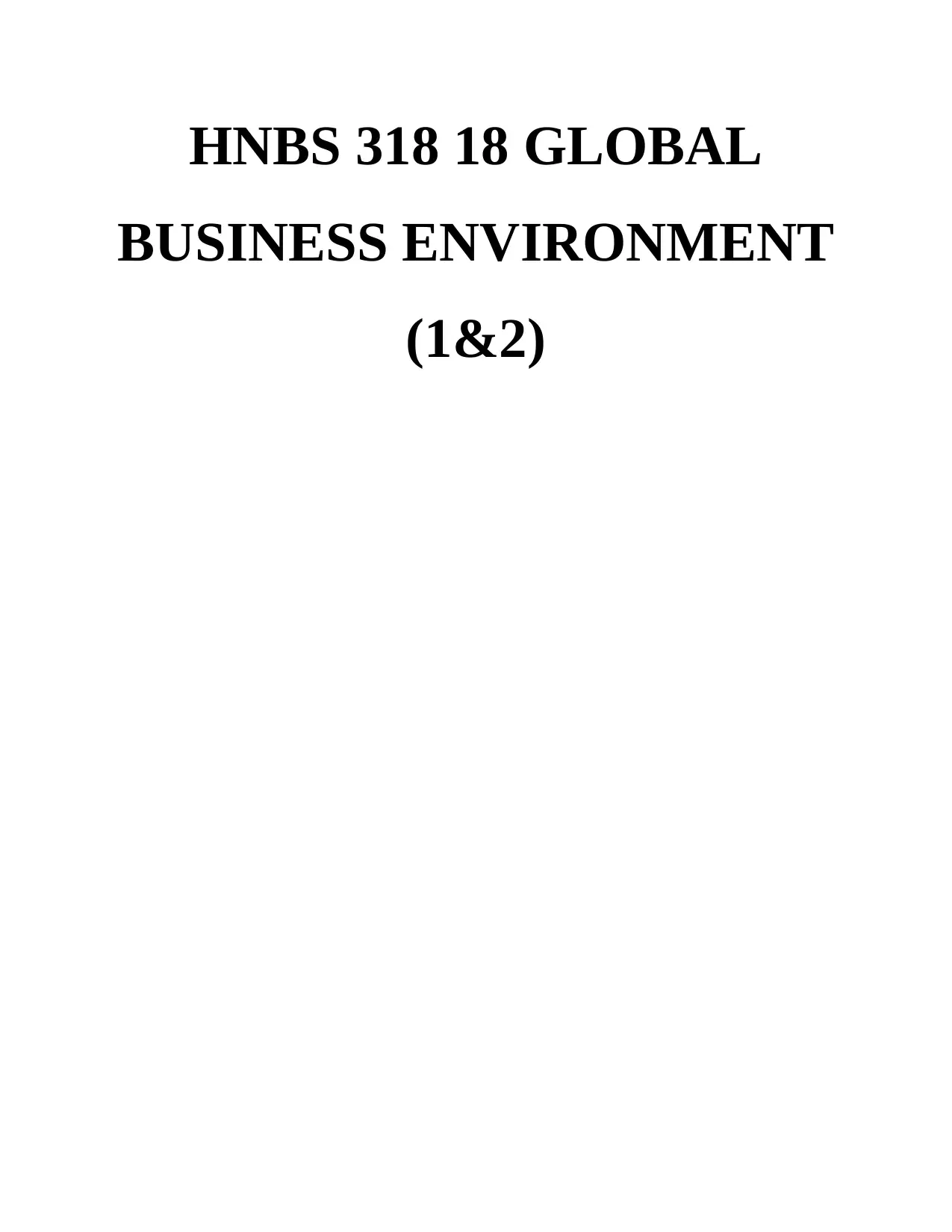
HNBS 318 18 GLOBAL
BUSINESS ENVIRONMENT
(1&2)
BUSINESS ENVIRONMENT
(1&2)
Paraphrase This Document
Need a fresh take? Get an instant paraphrase of this document with our AI Paraphraser
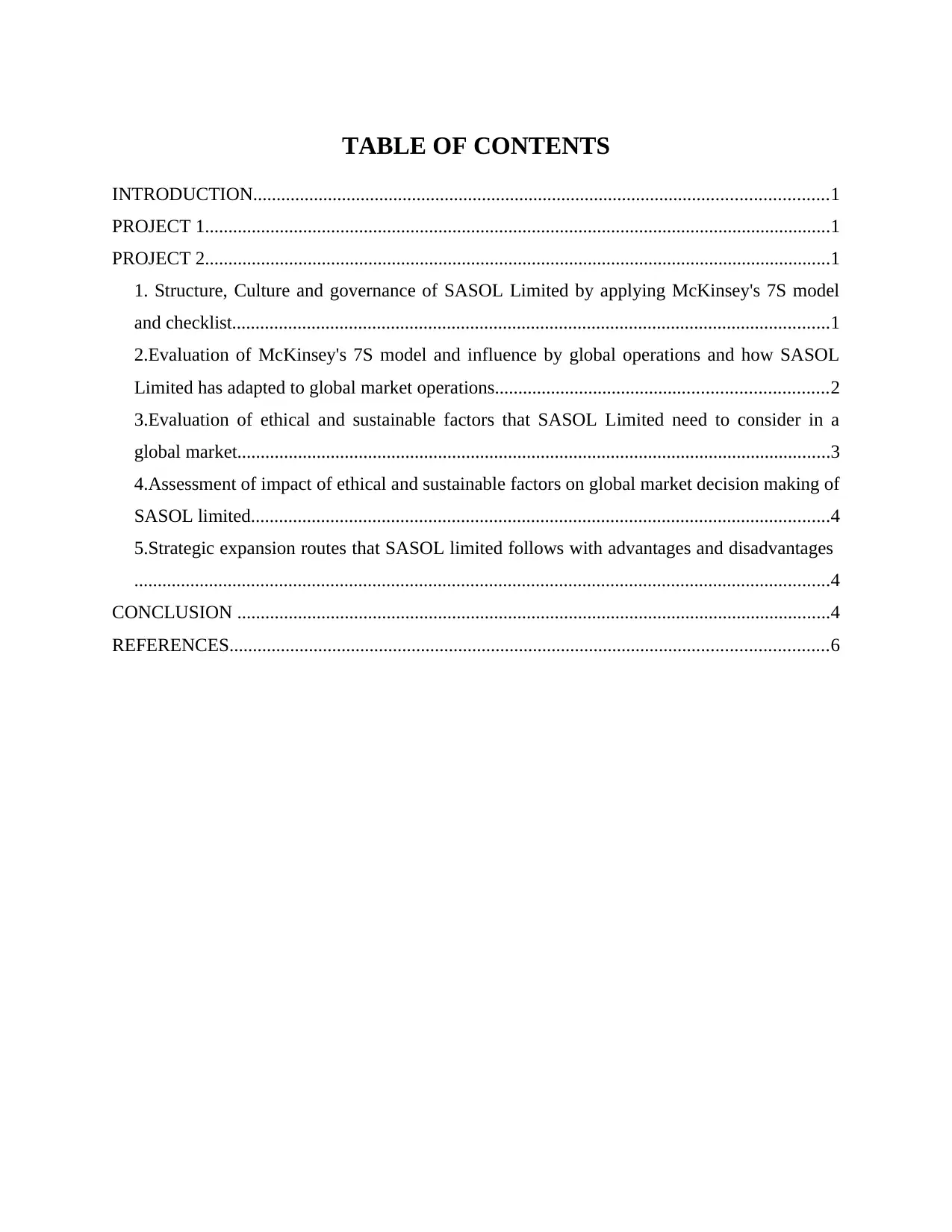
TABLE OF CONTENTS
INTRODUCTION...........................................................................................................................1
PROJECT 1......................................................................................................................................1
PROJECT 2......................................................................................................................................1
1. Structure, Culture and governance of SASOL Limited by applying McKinsey's 7S model
and checklist................................................................................................................................1
2.Evaluation of McKinsey's 7S model and influence by global operations and how SASOL
Limited has adapted to global market operations.......................................................................2
3.Evaluation of ethical and sustainable factors that SASOL Limited need to consider in a
global market...............................................................................................................................3
4.Assessment of impact of ethical and sustainable factors on global market decision making of
SASOL limited............................................................................................................................4
5.Strategic expansion routes that SASOL limited follows with advantages and disadvantages
.....................................................................................................................................................4
CONCLUSION ...............................................................................................................................4
REFERENCES................................................................................................................................6
INTRODUCTION...........................................................................................................................1
PROJECT 1......................................................................................................................................1
PROJECT 2......................................................................................................................................1
1. Structure, Culture and governance of SASOL Limited by applying McKinsey's 7S model
and checklist................................................................................................................................1
2.Evaluation of McKinsey's 7S model and influence by global operations and how SASOL
Limited has adapted to global market operations.......................................................................2
3.Evaluation of ethical and sustainable factors that SASOL Limited need to consider in a
global market...............................................................................................................................3
4.Assessment of impact of ethical and sustainable factors on global market decision making of
SASOL limited............................................................................................................................4
5.Strategic expansion routes that SASOL limited follows with advantages and disadvantages
.....................................................................................................................................................4
CONCLUSION ...............................................................................................................................4
REFERENCES................................................................................................................................6

INTRODUCTION
Global Business Environment is the international interactions out of an organization's
control that influences its business operations, decision making on resource utilization.
International business environment are of two types; external and internal environment that may
cause various advantages and challenges to a business organization. This business report is
prepared to understand the drivers and challenges for globalisation and impact and strategic
directions. For the assessment SASOL Limited, a South Africa based energy and chemical
company is chosen that is hooping to expand into other countries. Report will also analyse the
concept of globalisation and challenges it creates for global business of SASOL Limited
planning to enter new markets. It will investigate how globalisation affects decision-making and
strategies within global business of SASOL Limited.
PROJECT 1
Enclosed in PPT.
1
Global Business Environment is the international interactions out of an organization's
control that influences its business operations, decision making on resource utilization.
International business environment are of two types; external and internal environment that may
cause various advantages and challenges to a business organization. This business report is
prepared to understand the drivers and challenges for globalisation and impact and strategic
directions. For the assessment SASOL Limited, a South Africa based energy and chemical
company is chosen that is hooping to expand into other countries. Report will also analyse the
concept of globalisation and challenges it creates for global business of SASOL Limited
planning to enter new markets. It will investigate how globalisation affects decision-making and
strategies within global business of SASOL Limited.
PROJECT 1
Enclosed in PPT.
1
⊘ This is a preview!⊘
Do you want full access?
Subscribe today to unlock all pages.

Trusted by 1+ million students worldwide
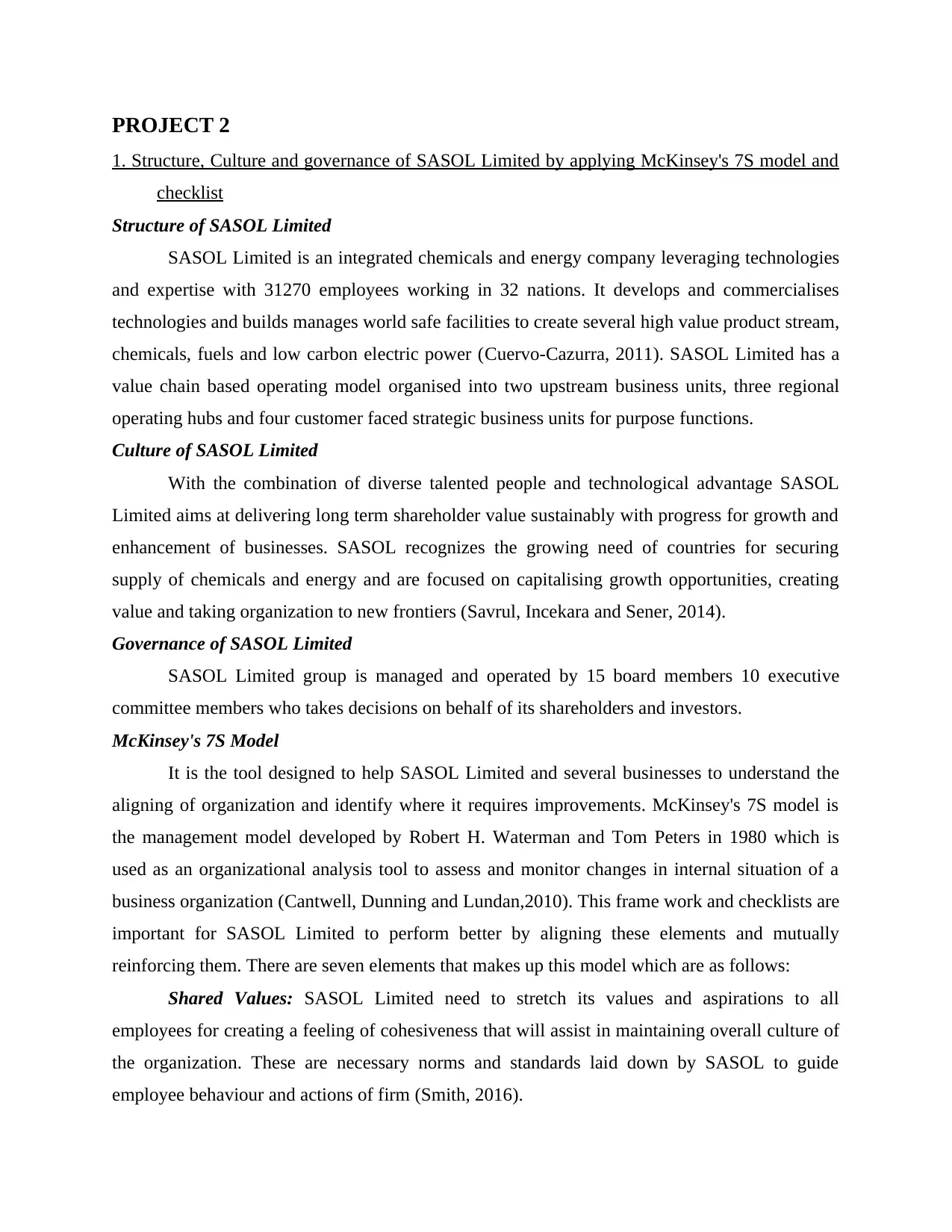
PROJECT 2
1. Structure, Culture and governance of SASOL Limited by applying McKinsey's 7S model and
checklist
Structure of SASOL Limited
SASOL Limited is an integrated chemicals and energy company leveraging technologies
and expertise with 31270 employees working in 32 nations. It develops and commercialises
technologies and builds manages world safe facilities to create several high value product stream,
chemicals, fuels and low carbon electric power (Cuervo‐Cazurra, 2011). SASOL Limited has a
value chain based operating model organised into two upstream business units, three regional
operating hubs and four customer faced strategic business units for purpose functions.
Culture of SASOL Limited
With the combination of diverse talented people and technological advantage SASOL
Limited aims at delivering long term shareholder value sustainably with progress for growth and
enhancement of businesses. SASOL recognizes the growing need of countries for securing
supply of chemicals and energy and are focused on capitalising growth opportunities, creating
value and taking organization to new frontiers (Savrul, Incekara and Sener, 2014).
Governance of SASOL Limited
SASOL Limited group is managed and operated by 15 board members 10 executive
committee members who takes decisions on behalf of its shareholders and investors.
McKinsey's 7S Model
It is the tool designed to help SASOL Limited and several businesses to understand the
aligning of organization and identify where it requires improvements. McKinsey's 7S model is
the management model developed by Robert H. Waterman and Tom Peters in 1980 which is
used as an organizational analysis tool to assess and monitor changes in internal situation of a
business organization (Cantwell, Dunning and Lundan,2010). This frame work and checklists are
important for SASOL Limited to perform better by aligning these elements and mutually
reinforcing them. There are seven elements that makes up this model which are as follows:
Shared Values: SASOL Limited need to stretch its values and aspirations to all
employees for creating a feeling of cohesiveness that will assist in maintaining overall culture of
the organization. These are necessary norms and standards laid down by SASOL to guide
employee behaviour and actions of firm (Smith, 2016).
1. Structure, Culture and governance of SASOL Limited by applying McKinsey's 7S model and
checklist
Structure of SASOL Limited
SASOL Limited is an integrated chemicals and energy company leveraging technologies
and expertise with 31270 employees working in 32 nations. It develops and commercialises
technologies and builds manages world safe facilities to create several high value product stream,
chemicals, fuels and low carbon electric power (Cuervo‐Cazurra, 2011). SASOL Limited has a
value chain based operating model organised into two upstream business units, three regional
operating hubs and four customer faced strategic business units for purpose functions.
Culture of SASOL Limited
With the combination of diverse talented people and technological advantage SASOL
Limited aims at delivering long term shareholder value sustainably with progress for growth and
enhancement of businesses. SASOL recognizes the growing need of countries for securing
supply of chemicals and energy and are focused on capitalising growth opportunities, creating
value and taking organization to new frontiers (Savrul, Incekara and Sener, 2014).
Governance of SASOL Limited
SASOL Limited group is managed and operated by 15 board members 10 executive
committee members who takes decisions on behalf of its shareholders and investors.
McKinsey's 7S Model
It is the tool designed to help SASOL Limited and several businesses to understand the
aligning of organization and identify where it requires improvements. McKinsey's 7S model is
the management model developed by Robert H. Waterman and Tom Peters in 1980 which is
used as an organizational analysis tool to assess and monitor changes in internal situation of a
business organization (Cantwell, Dunning and Lundan,2010). This frame work and checklists are
important for SASOL Limited to perform better by aligning these elements and mutually
reinforcing them. There are seven elements that makes up this model which are as follows:
Shared Values: SASOL Limited need to stretch its values and aspirations to all
employees for creating a feeling of cohesiveness that will assist in maintaining overall culture of
the organization. These are necessary norms and standards laid down by SASOL to guide
employee behaviour and actions of firm (Smith, 2016).
Paraphrase This Document
Need a fresh take? Get an instant paraphrase of this document with our AI Paraphraser
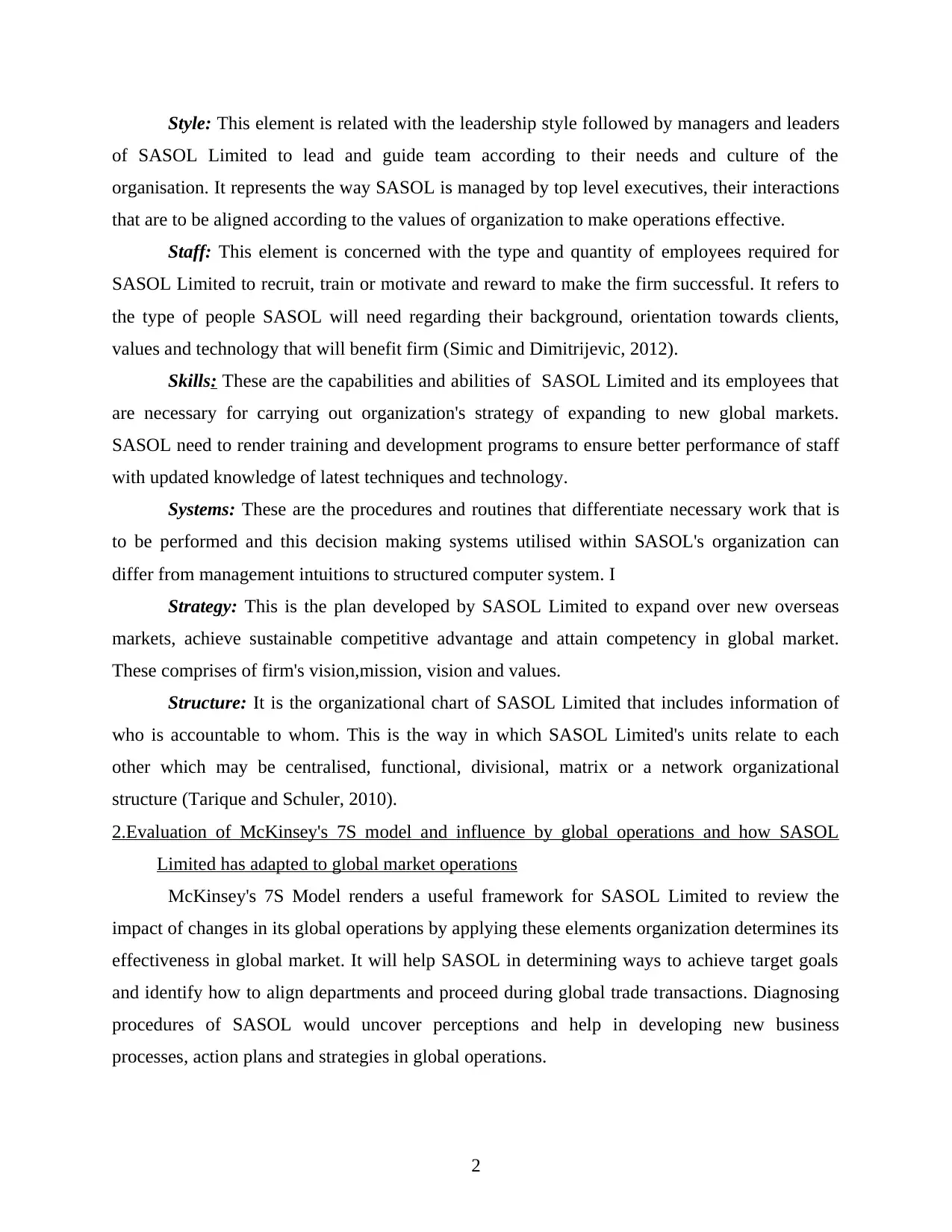
Style: This element is related with the leadership style followed by managers and leaders
of SASOL Limited to lead and guide team according to their needs and culture of the
organisation. It represents the way SASOL is managed by top level executives, their interactions
that are to be aligned according to the values of organization to make operations effective.
Staff: This element is concerned with the type and quantity of employees required for
SASOL Limited to recruit, train or motivate and reward to make the firm successful. It refers to
the type of people SASOL will need regarding their background, orientation towards clients,
values and technology that will benefit firm (Simic and Dimitrijevic, 2012).
Skills: These are the capabilities and abilities of SASOL Limited and its employees that
are necessary for carrying out organization's strategy of expanding to new global markets.
SASOL need to render training and development programs to ensure better performance of staff
with updated knowledge of latest techniques and technology.
Systems: These are the procedures and routines that differentiate necessary work that is
to be performed and this decision making systems utilised within SASOL's organization can
differ from management intuitions to structured computer system. I
Strategy: This is the plan developed by SASOL Limited to expand over new overseas
markets, achieve sustainable competitive advantage and attain competency in global market.
These comprises of firm's vision,mission, vision and values.
Structure: It is the organizational chart of SASOL Limited that includes information of
who is accountable to whom. This is the way in which SASOL Limited's units relate to each
other which may be centralised, functional, divisional, matrix or a network organizational
structure (Tarique and Schuler, 2010).
2.Evaluation of McKinsey's 7S model and influence by global operations and how SASOL
Limited has adapted to global market operations
McKinsey's 7S Model renders a useful framework for SASOL Limited to review the
impact of changes in its global operations by applying these elements organization determines its
effectiveness in global market. It will help SASOL in determining ways to achieve target goals
and identify how to align departments and proceed during global trade transactions. Diagnosing
procedures of SASOL would uncover perceptions and help in developing new business
processes, action plans and strategies in global operations.
2
of SASOL Limited to lead and guide team according to their needs and culture of the
organisation. It represents the way SASOL is managed by top level executives, their interactions
that are to be aligned according to the values of organization to make operations effective.
Staff: This element is concerned with the type and quantity of employees required for
SASOL Limited to recruit, train or motivate and reward to make the firm successful. It refers to
the type of people SASOL will need regarding their background, orientation towards clients,
values and technology that will benefit firm (Simic and Dimitrijevic, 2012).
Skills: These are the capabilities and abilities of SASOL Limited and its employees that
are necessary for carrying out organization's strategy of expanding to new global markets.
SASOL need to render training and development programs to ensure better performance of staff
with updated knowledge of latest techniques and technology.
Systems: These are the procedures and routines that differentiate necessary work that is
to be performed and this decision making systems utilised within SASOL's organization can
differ from management intuitions to structured computer system. I
Strategy: This is the plan developed by SASOL Limited to expand over new overseas
markets, achieve sustainable competitive advantage and attain competency in global market.
These comprises of firm's vision,mission, vision and values.
Structure: It is the organizational chart of SASOL Limited that includes information of
who is accountable to whom. This is the way in which SASOL Limited's units relate to each
other which may be centralised, functional, divisional, matrix or a network organizational
structure (Tarique and Schuler, 2010).
2.Evaluation of McKinsey's 7S model and influence by global operations and how SASOL
Limited has adapted to global market operations
McKinsey's 7S Model renders a useful framework for SASOL Limited to review the
impact of changes in its global operations by applying these elements organization determines its
effectiveness in global market. It will help SASOL in determining ways to achieve target goals
and identify how to align departments and proceed during global trade transactions. Diagnosing
procedures of SASOL would uncover perceptions and help in developing new business
processes, action plans and strategies in global operations.
2
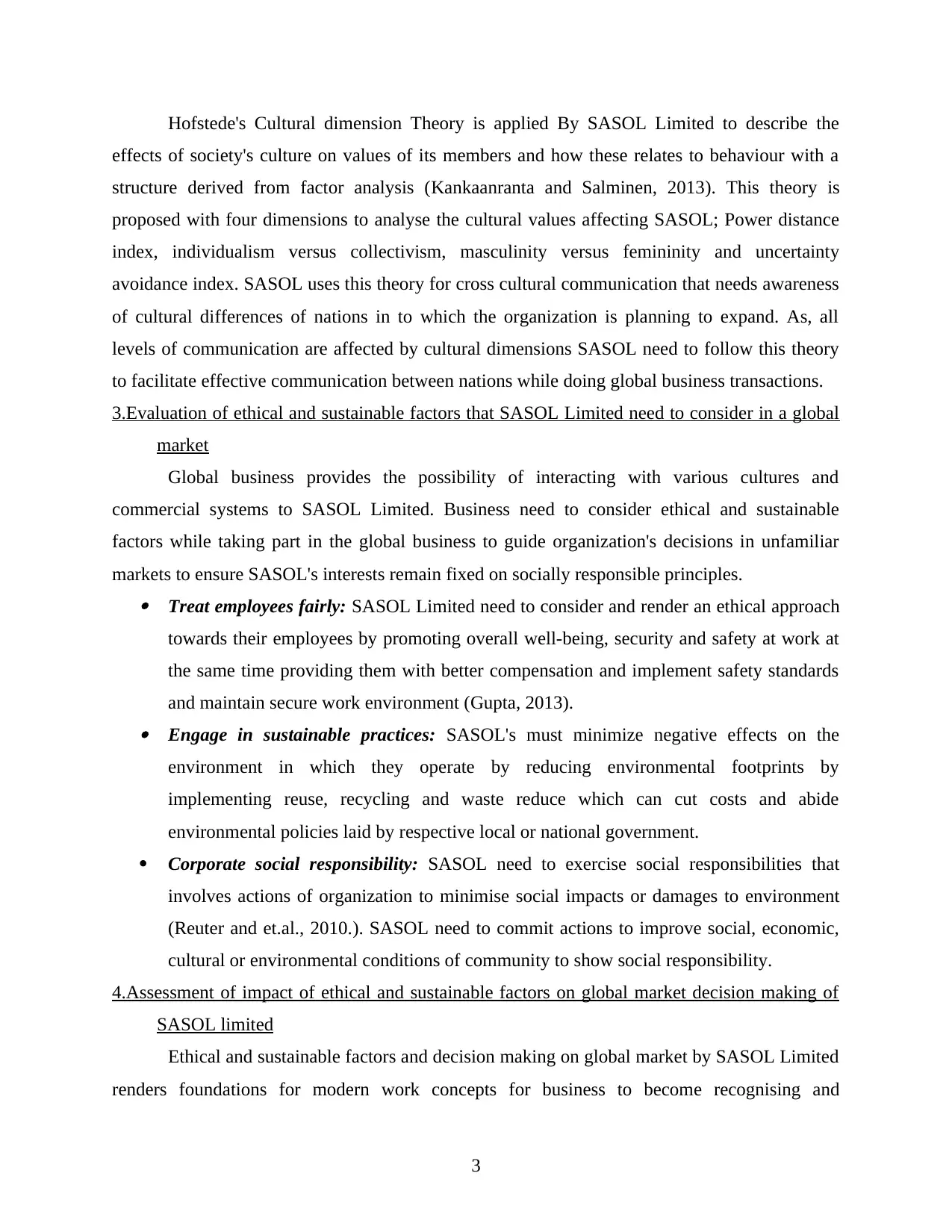
Hofstede's Cultural dimension Theory is applied By SASOL Limited to describe the
effects of society's culture on values of its members and how these relates to behaviour with a
structure derived from factor analysis (Kankaanranta and Salminen, 2013). This theory is
proposed with four dimensions to analyse the cultural values affecting SASOL; Power distance
index, individualism versus collectivism, masculinity versus femininity and uncertainty
avoidance index. SASOL uses this theory for cross cultural communication that needs awareness
of cultural differences of nations in to which the organization is planning to expand. As, all
levels of communication are affected by cultural dimensions SASOL need to follow this theory
to facilitate effective communication between nations while doing global business transactions.
3.Evaluation of ethical and sustainable factors that SASOL Limited need to consider in a global
market
Global business provides the possibility of interacting with various cultures and
commercial systems to SASOL Limited. Business need to consider ethical and sustainable
factors while taking part in the global business to guide organization's decisions in unfamiliar
markets to ensure SASOL's interests remain fixed on socially responsible principles. Treat employees fairly: SASOL Limited need to consider and render an ethical approach
towards their employees by promoting overall well-being, security and safety at work at
the same time providing them with better compensation and implement safety standards
and maintain secure work environment (Gupta, 2013). Engage in sustainable practices: SASOL's must minimize negative effects on the
environment in which they operate by reducing environmental footprints by
implementing reuse, recycling and waste reduce which can cut costs and abide
environmental policies laid by respective local or national government.
Corporate social responsibility: SASOL need to exercise social responsibilities that
involves actions of organization to minimise social impacts or damages to environment
(Reuter and et.al., 2010.). SASOL need to commit actions to improve social, economic,
cultural or environmental conditions of community to show social responsibility.
4.Assessment of impact of ethical and sustainable factors on global market decision making of
SASOL limited
Ethical and sustainable factors and decision making on global market by SASOL Limited
renders foundations for modern work concepts for business to become recognising and
3
effects of society's culture on values of its members and how these relates to behaviour with a
structure derived from factor analysis (Kankaanranta and Salminen, 2013). This theory is
proposed with four dimensions to analyse the cultural values affecting SASOL; Power distance
index, individualism versus collectivism, masculinity versus femininity and uncertainty
avoidance index. SASOL uses this theory for cross cultural communication that needs awareness
of cultural differences of nations in to which the organization is planning to expand. As, all
levels of communication are affected by cultural dimensions SASOL need to follow this theory
to facilitate effective communication between nations while doing global business transactions.
3.Evaluation of ethical and sustainable factors that SASOL Limited need to consider in a global
market
Global business provides the possibility of interacting with various cultures and
commercial systems to SASOL Limited. Business need to consider ethical and sustainable
factors while taking part in the global business to guide organization's decisions in unfamiliar
markets to ensure SASOL's interests remain fixed on socially responsible principles. Treat employees fairly: SASOL Limited need to consider and render an ethical approach
towards their employees by promoting overall well-being, security and safety at work at
the same time providing them with better compensation and implement safety standards
and maintain secure work environment (Gupta, 2013). Engage in sustainable practices: SASOL's must minimize negative effects on the
environment in which they operate by reducing environmental footprints by
implementing reuse, recycling and waste reduce which can cut costs and abide
environmental policies laid by respective local or national government.
Corporate social responsibility: SASOL need to exercise social responsibilities that
involves actions of organization to minimise social impacts or damages to environment
(Reuter and et.al., 2010.). SASOL need to commit actions to improve social, economic,
cultural or environmental conditions of community to show social responsibility.
4.Assessment of impact of ethical and sustainable factors on global market decision making of
SASOL limited
Ethical and sustainable factors and decision making on global market by SASOL Limited
renders foundations for modern work concepts for business to become recognising and
3
⊘ This is a preview!⊘
Do you want full access?
Subscribe today to unlock all pages.

Trusted by 1+ million students worldwide
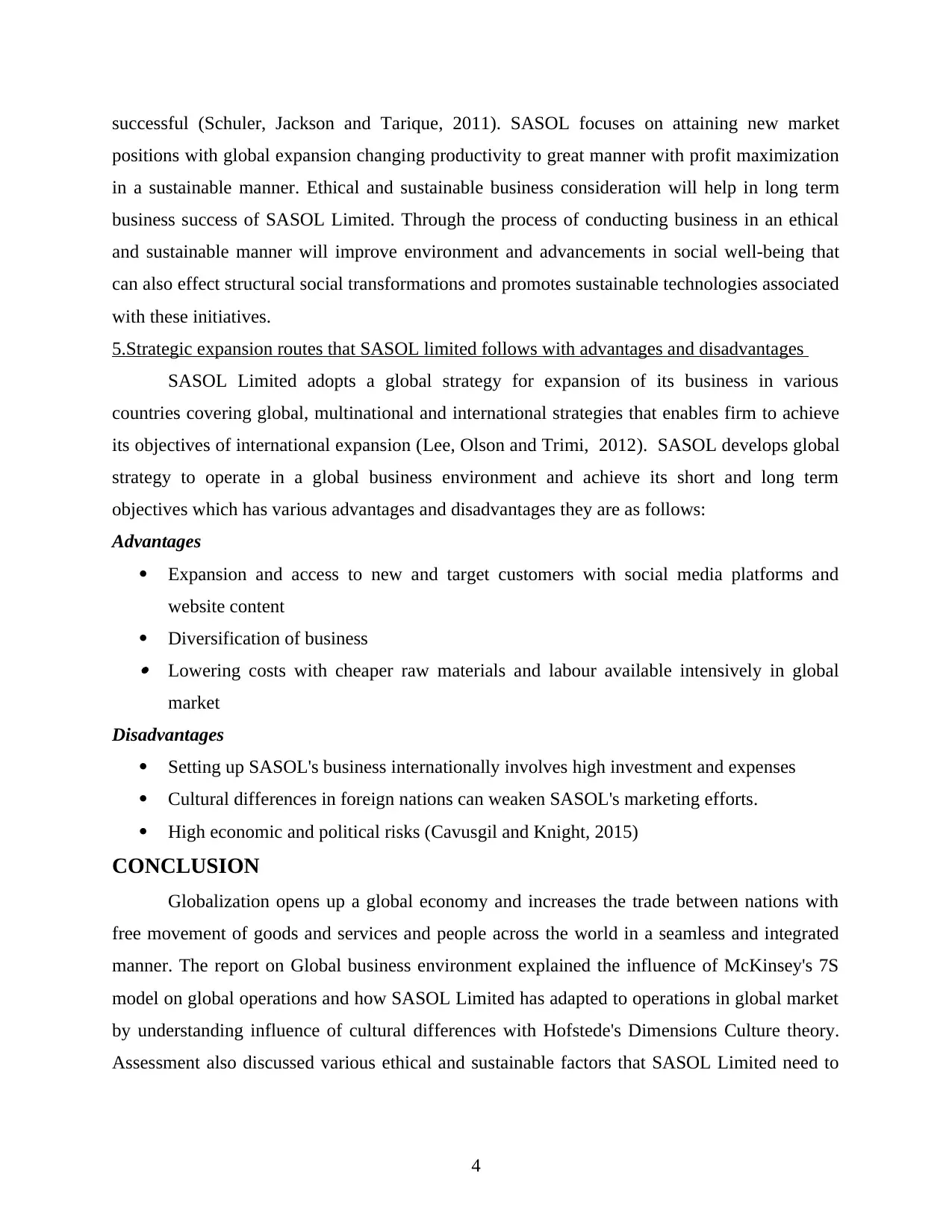
successful (Schuler, Jackson and Tarique, 2011). SASOL focuses on attaining new market
positions with global expansion changing productivity to great manner with profit maximization
in a sustainable manner. Ethical and sustainable business consideration will help in long term
business success of SASOL Limited. Through the process of conducting business in an ethical
and sustainable manner will improve environment and advancements in social well-being that
can also effect structural social transformations and promotes sustainable technologies associated
with these initiatives.
5.Strategic expansion routes that SASOL limited follows with advantages and disadvantages
SASOL Limited adopts a global strategy for expansion of its business in various
countries covering global, multinational and international strategies that enables firm to achieve
its objectives of international expansion (Lee, Olson and Trimi, 2012). SASOL develops global
strategy to operate in a global business environment and achieve its short and long term
objectives which has various advantages and disadvantages they are as follows:
Advantages
Expansion and access to new and target customers with social media platforms and
website content
Diversification of business Lowering costs with cheaper raw materials and labour available intensively in global
market
Disadvantages
Setting up SASOL's business internationally involves high investment and expenses
Cultural differences in foreign nations can weaken SASOL's marketing efforts.
High economic and political risks (Cavusgil and Knight, 2015)
CONCLUSION
Globalization opens up a global economy and increases the trade between nations with
free movement of goods and services and people across the world in a seamless and integrated
manner. The report on Global business environment explained the influence of McKinsey's 7S
model on global operations and how SASOL Limited has adapted to operations in global market
by understanding influence of cultural differences with Hofstede's Dimensions Culture theory.
Assessment also discussed various ethical and sustainable factors that SASOL Limited need to
4
positions with global expansion changing productivity to great manner with profit maximization
in a sustainable manner. Ethical and sustainable business consideration will help in long term
business success of SASOL Limited. Through the process of conducting business in an ethical
and sustainable manner will improve environment and advancements in social well-being that
can also effect structural social transformations and promotes sustainable technologies associated
with these initiatives.
5.Strategic expansion routes that SASOL limited follows with advantages and disadvantages
SASOL Limited adopts a global strategy for expansion of its business in various
countries covering global, multinational and international strategies that enables firm to achieve
its objectives of international expansion (Lee, Olson and Trimi, 2012). SASOL develops global
strategy to operate in a global business environment and achieve its short and long term
objectives which has various advantages and disadvantages they are as follows:
Advantages
Expansion and access to new and target customers with social media platforms and
website content
Diversification of business Lowering costs with cheaper raw materials and labour available intensively in global
market
Disadvantages
Setting up SASOL's business internationally involves high investment and expenses
Cultural differences in foreign nations can weaken SASOL's marketing efforts.
High economic and political risks (Cavusgil and Knight, 2015)
CONCLUSION
Globalization opens up a global economy and increases the trade between nations with
free movement of goods and services and people across the world in a seamless and integrated
manner. The report on Global business environment explained the influence of McKinsey's 7S
model on global operations and how SASOL Limited has adapted to operations in global market
by understanding influence of cultural differences with Hofstede's Dimensions Culture theory.
Assessment also discussed various ethical and sustainable factors that SASOL Limited need to
4
Paraphrase This Document
Need a fresh take? Get an instant paraphrase of this document with our AI Paraphraser
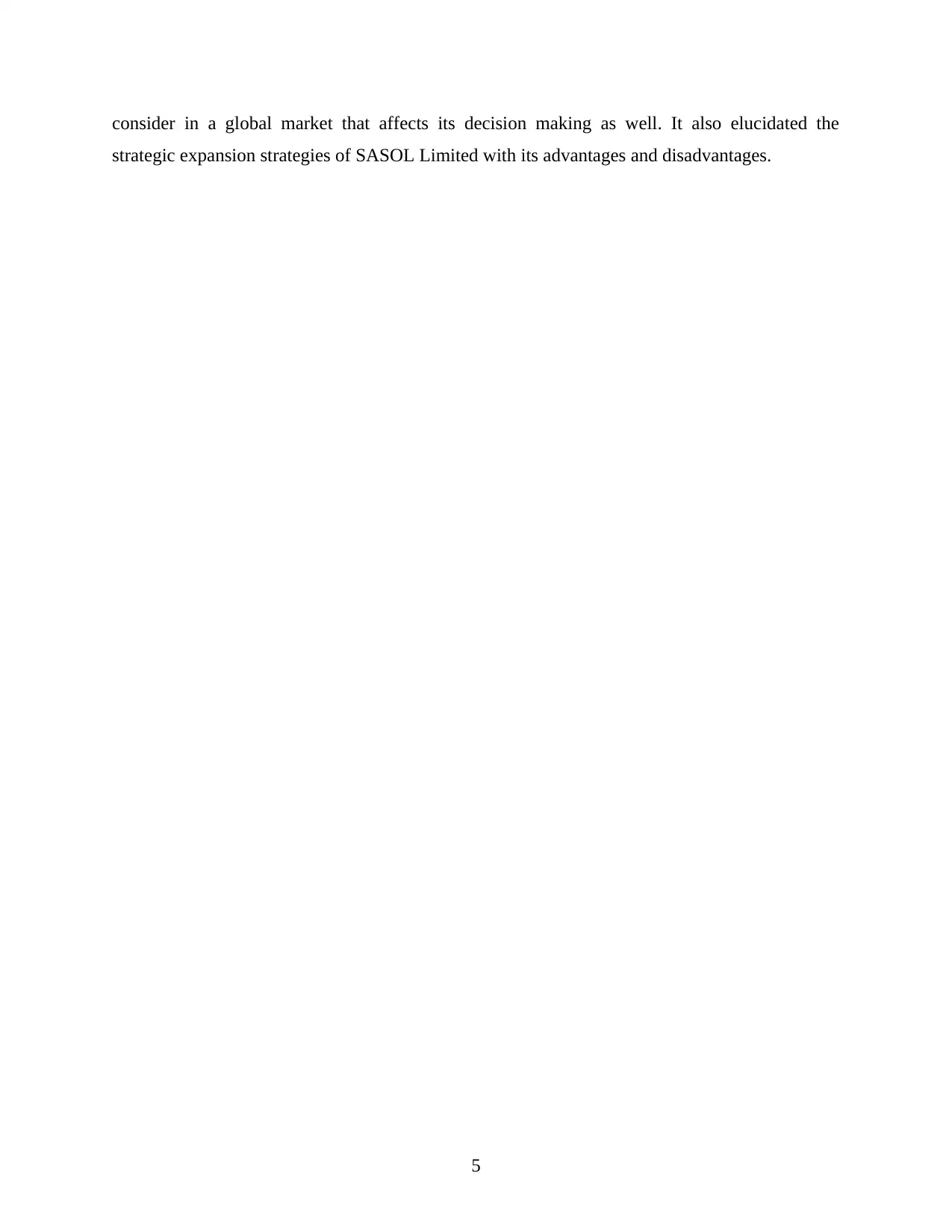
consider in a global market that affects its decision making as well. It also elucidated the
strategic expansion strategies of SASOL Limited with its advantages and disadvantages.
5
strategic expansion strategies of SASOL Limited with its advantages and disadvantages.
5
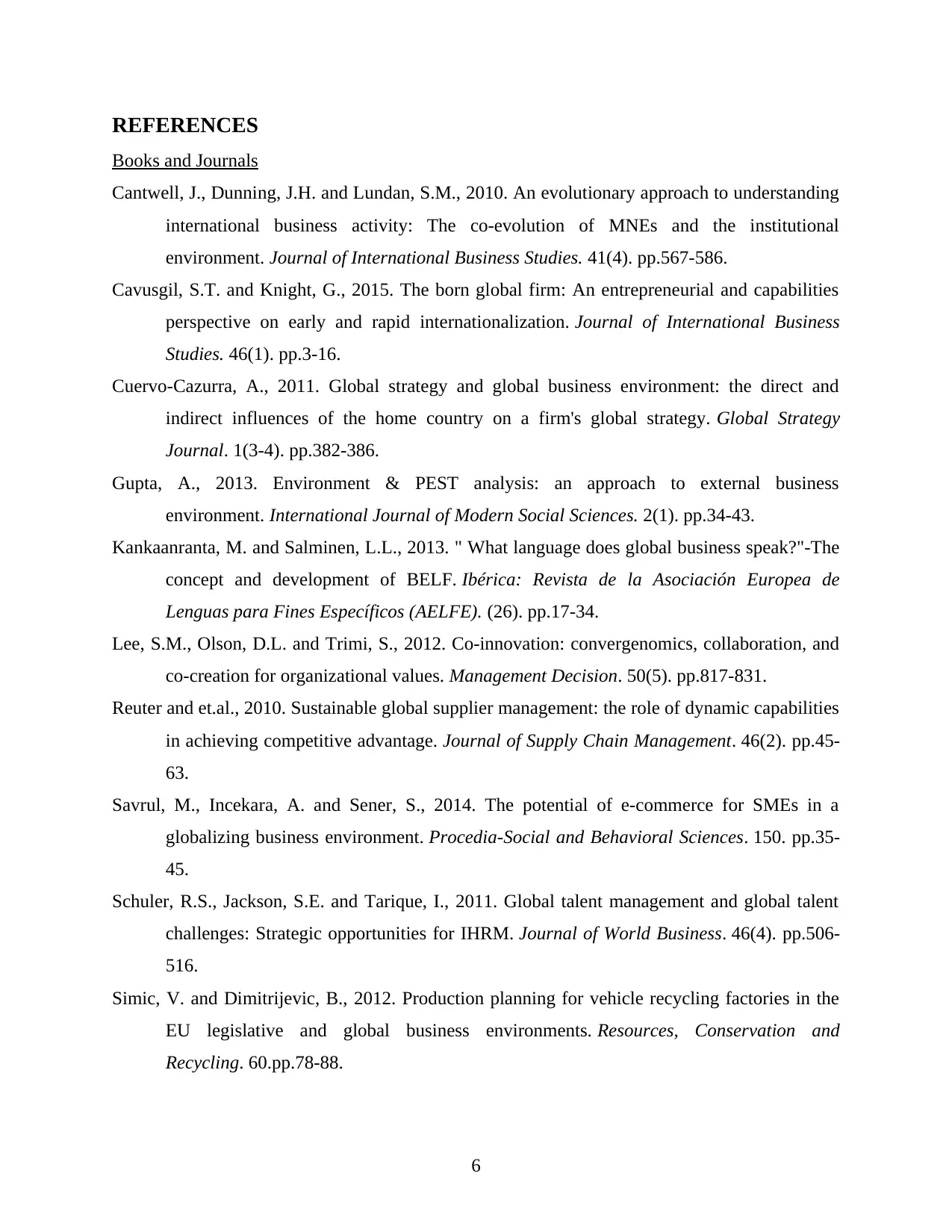
REFERENCES
Books and Journals
Cantwell, J., Dunning, J.H. and Lundan, S.M., 2010. An evolutionary approach to understanding
international business activity: The co-evolution of MNEs and the institutional
environment. Journal of International Business Studies. 41(4). pp.567-586.
Cavusgil, S.T. and Knight, G., 2015. The born global firm: An entrepreneurial and capabilities
perspective on early and rapid internationalization. Journal of International Business
Studies. 46(1). pp.3-16.
Cuervo‐Cazurra, A., 2011. Global strategy and global business environment: the direct and
indirect influences of the home country on a firm's global strategy. Global Strategy
Journal. 1(3‐4). pp.382-386.
Gupta, A., 2013. Environment & PEST analysis: an approach to external business
environment. International Journal of Modern Social Sciences. 2(1). pp.34-43.
Kankaanranta, M. and Salminen, L.L., 2013. " What language does global business speak?"-The
concept and development of BELF. Ibérica: Revista de la Asociación Europea de
Lenguas para Fines Específicos (AELFE). (26). pp.17-34.
Lee, S.M., Olson, D.L. and Trimi, S., 2012. Co-innovation: convergenomics, collaboration, and
co-creation for organizational values. Management Decision. 50(5). pp.817-831.
Reuter and et.al., 2010. Sustainable global supplier management: the role of dynamic capabilities
in achieving competitive advantage. Journal of Supply Chain Management. 46(2). pp.45-
63.
Savrul, M., Incekara, A. and Sener, S., 2014. The potential of e-commerce for SMEs in a
globalizing business environment. Procedia-Social and Behavioral Sciences. 150. pp.35-
45.
Schuler, R.S., Jackson, S.E. and Tarique, I., 2011. Global talent management and global talent
challenges: Strategic opportunities for IHRM. Journal of World Business. 46(4). pp.506-
516.
Simic, V. and Dimitrijevic, B., 2012. Production planning for vehicle recycling factories in the
EU legislative and global business environments. Resources, Conservation and
Recycling. 60.pp.78-88.
6
Books and Journals
Cantwell, J., Dunning, J.H. and Lundan, S.M., 2010. An evolutionary approach to understanding
international business activity: The co-evolution of MNEs and the institutional
environment. Journal of International Business Studies. 41(4). pp.567-586.
Cavusgil, S.T. and Knight, G., 2015. The born global firm: An entrepreneurial and capabilities
perspective on early and rapid internationalization. Journal of International Business
Studies. 46(1). pp.3-16.
Cuervo‐Cazurra, A., 2011. Global strategy and global business environment: the direct and
indirect influences of the home country on a firm's global strategy. Global Strategy
Journal. 1(3‐4). pp.382-386.
Gupta, A., 2013. Environment & PEST analysis: an approach to external business
environment. International Journal of Modern Social Sciences. 2(1). pp.34-43.
Kankaanranta, M. and Salminen, L.L., 2013. " What language does global business speak?"-The
concept and development of BELF. Ibérica: Revista de la Asociación Europea de
Lenguas para Fines Específicos (AELFE). (26). pp.17-34.
Lee, S.M., Olson, D.L. and Trimi, S., 2012. Co-innovation: convergenomics, collaboration, and
co-creation for organizational values. Management Decision. 50(5). pp.817-831.
Reuter and et.al., 2010. Sustainable global supplier management: the role of dynamic capabilities
in achieving competitive advantage. Journal of Supply Chain Management. 46(2). pp.45-
63.
Savrul, M., Incekara, A. and Sener, S., 2014. The potential of e-commerce for SMEs in a
globalizing business environment. Procedia-Social and Behavioral Sciences. 150. pp.35-
45.
Schuler, R.S., Jackson, S.E. and Tarique, I., 2011. Global talent management and global talent
challenges: Strategic opportunities for IHRM. Journal of World Business. 46(4). pp.506-
516.
Simic, V. and Dimitrijevic, B., 2012. Production planning for vehicle recycling factories in the
EU legislative and global business environments. Resources, Conservation and
Recycling. 60.pp.78-88.
6
⊘ This is a preview!⊘
Do you want full access?
Subscribe today to unlock all pages.

Trusted by 1+ million students worldwide
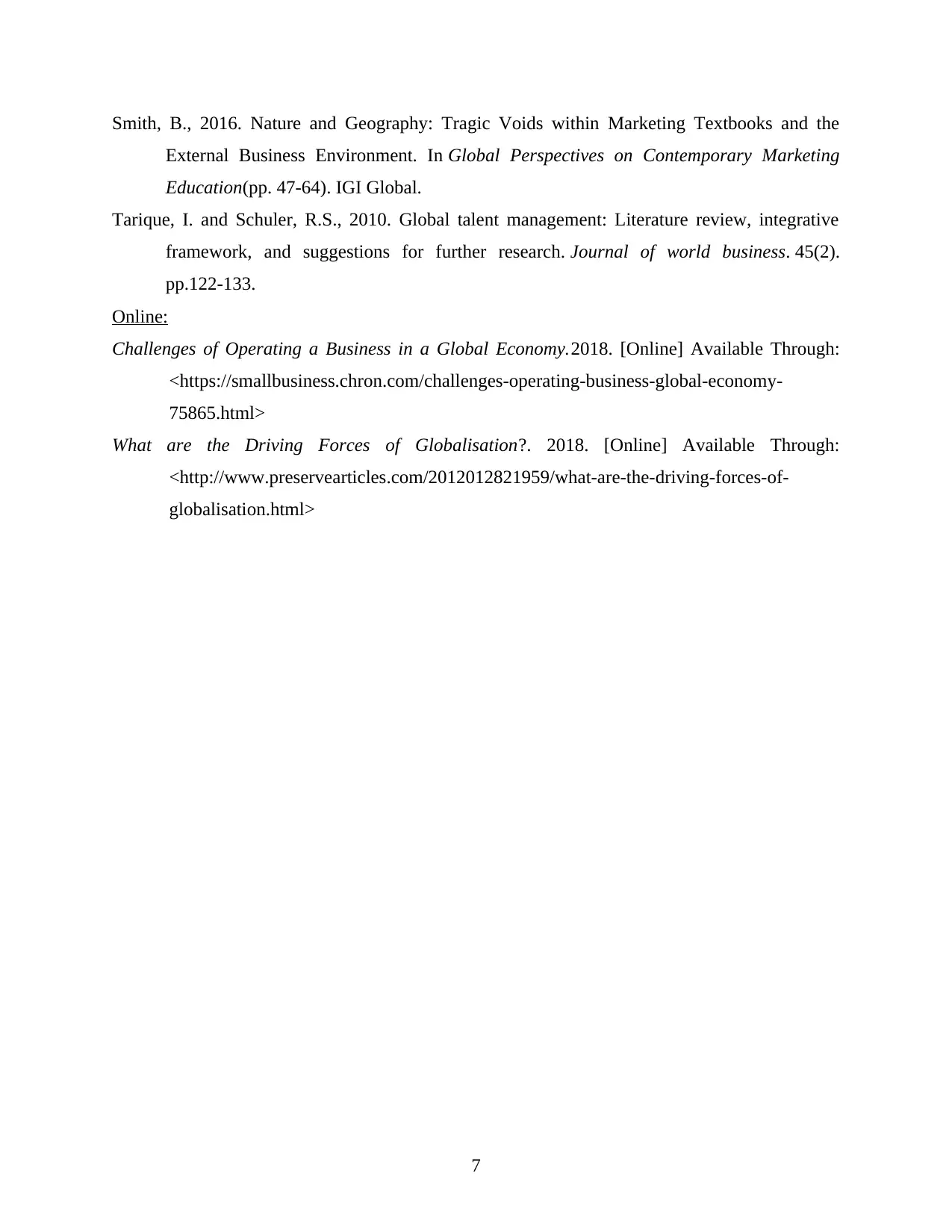
Smith, B., 2016. Nature and Geography: Tragic Voids within Marketing Textbooks and the
External Business Environment. In Global Perspectives on Contemporary Marketing
Education(pp. 47-64). IGI Global.
Tarique, I. and Schuler, R.S., 2010. Global talent management: Literature review, integrative
framework, and suggestions for further research. Journal of world business. 45(2).
pp.122-133.
Online:
Challenges of Operating a Business in a Global Economy.2018. [Online] Available Through:
<https://smallbusiness.chron.com/challenges-operating-business-global-economy-
75865.html>
What are the Driving Forces of Globalisation?. 2018. [Online] Available Through:
<http://www.preservearticles.com/2012012821959/what-are-the-driving-forces-of-
globalisation.html>
7
External Business Environment. In Global Perspectives on Contemporary Marketing
Education(pp. 47-64). IGI Global.
Tarique, I. and Schuler, R.S., 2010. Global talent management: Literature review, integrative
framework, and suggestions for further research. Journal of world business. 45(2).
pp.122-133.
Online:
Challenges of Operating a Business in a Global Economy.2018. [Online] Available Through:
<https://smallbusiness.chron.com/challenges-operating-business-global-economy-
75865.html>
What are the Driving Forces of Globalisation?. 2018. [Online] Available Through:
<http://www.preservearticles.com/2012012821959/what-are-the-driving-forces-of-
globalisation.html>
7
1 out of 10
Related Documents
Your All-in-One AI-Powered Toolkit for Academic Success.
+13062052269
info@desklib.com
Available 24*7 on WhatsApp / Email
![[object Object]](/_next/static/media/star-bottom.7253800d.svg)
Unlock your academic potential
Copyright © 2020–2025 A2Z Services. All Rights Reserved. Developed and managed by ZUCOL.



